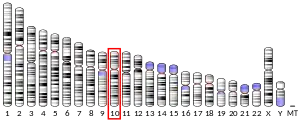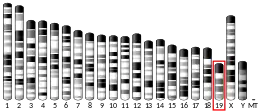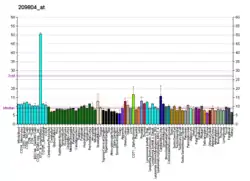| DCLRE1A | |||||||||||||||||||||||||||||||||||||||||||||||||||
|---|---|---|---|---|---|---|---|---|---|---|---|---|---|---|---|---|---|---|---|---|---|---|---|---|---|---|---|---|---|---|---|---|---|---|---|---|---|---|---|---|---|---|---|---|---|---|---|---|---|---|---|
| |||||||||||||||||||||||||||||||||||||||||||||||||||
| Identifiers | |||||||||||||||||||||||||||||||||||||||||||||||||||
| Aliases | DCLRE1A, PSO2, SNM1, SNM1A, DNA cross-link repair 1A | ||||||||||||||||||||||||||||||||||||||||||||||||||
| External IDs | OMIM: 609682 MGI: 1930042 HomoloGene: 8920 GeneCards: DCLRE1A | ||||||||||||||||||||||||||||||||||||||||||||||||||
| |||||||||||||||||||||||||||||||||||||||||||||||||||
| |||||||||||||||||||||||||||||||||||||||||||||||||||
| |||||||||||||||||||||||||||||||||||||||||||||||||||
| |||||||||||||||||||||||||||||||||||||||||||||||||||
| |||||||||||||||||||||||||||||||||||||||||||||||||||
| Wikidata | |||||||||||||||||||||||||||||||||||||||||||||||||||
| |||||||||||||||||||||||||||||||||||||||||||||||||||
DNA cross-link repair 1A protein is a protein that in humans is encoded by the DCLRE1A gene.[5][6][7]
DNA interstrand cross-links prevent strand separation, thereby physically blocking transcription, replication, and segregation of DNA. DCLRE1A is one of several evolutionarily conserved genes involved in repair of interstrand cross-links (Dronkert et al., 2000).[supplied by OMIM][7]
Function
The protein DCLRE1A (DNA cross-link repair 1A) is also referred to as SNM1A (sensitive to nitrogen mustard 1A). DCLRE1A is a 5’ to 3’ exonuclease that forms a complex with the Cockayne syndrome B (CSB) protein. In this complex, CSB modulates the exonuclease activity of DCLRE1A and coordinates the efficient assembly of DCLRE1A to sites of DNA damage.[8] In human cells, this complex is recruited to DNA inter-strand cross-links, a form of DNA damage. The complex then participates in the repair of the cross-linked DNA. DCLRE1A protein is thought to be recruited by CSB to facilitate cross-link unhooking following incision 5’ to the cross-link by another complex, the ERCC1/XPF nuclease complex.[8] Failure of the DCLRE1A/CSB complex to carry out its repair function may contribute to the degenerative pathologies and premature aging features of Cockayne syndrome.
References
- 1 2 3 GRCh38: Ensembl release 89: ENSG00000198924 - Ensembl, May 2017
- 1 2 3 GRCm38: Ensembl release 89: ENSMUSG00000025077 - Ensembl, May 2017
- ↑ "Human PubMed Reference:". National Center for Biotechnology Information, U.S. National Library of Medicine.
- ↑ "Mouse PubMed Reference:". National Center for Biotechnology Information, U.S. National Library of Medicine.
- ↑ Demuth I, Digweed M (Nov 1998). "Genomic organization of a potential human DNA-crosslink repair gene, KIAA0086". Mutat Res. 409 (1): 11–6. doi:10.1016/s0921-8777(98)00037-8. PMID 9806498.
- ↑ Hejna J, Philip S, Ott J, Faulkner C, Moses R (Oct 2007). "The hSNM1 protein is a DNA 5'-exonuclease". Nucleic Acids Res. 35 (18): 6115–23. doi:10.1093/nar/gkm530. PMC 2094091. PMID 17804464.
- 1 2 "Entrez Gene: DCLRE1A DNA cross-link repair 1A (PSO2 homolog, S. cerevisiae)".
- 1 2 Iyama T, Lee SY, Berquist BR, Gileadi O, Bohr VA, Seidman MM, McHugh PJ, Wilson DM (2015). "CSB interacts with SNM1A and promotes DNA interstrand crosslink processing". Nucleic Acids Res. 43 (1): 247–58. doi:10.1093/nar/gku1279. PMC 4288174. PMID 25505141.
Further reading
- Nagase T, Miyajima N, Tanaka A, et al. (1995). "Prediction of the coding sequences of unidentified human genes. III. The coding sequences of 40 new genes (KIAA0081-KIAA0120) deduced by analysis of cDNA clones from human cell line KG-1". DNA Res. 2 (1): 37–43. doi:10.1093/dnares/2.1.37. PMID 7788527.
- Dronkert ML, de Wit J, Boeve M, et al. (2000). "Disruption of mouse SNM1 causes increased sensitivity to the DNA interstrand cross-linking agent mitomycin C". Mol. Cell. Biol. 20 (13): 4553–61. doi:10.1128/MCB.20.13.4553-4561.2000. PMC 85844. PMID 10848582.
- Richie CT, Peterson C, Lu T, et al. (2003). "hSnm1 colocalizes and physically associates with 53BP1 before and after DNA damage". Mol. Cell. Biol. 22 (24): 8635–47. doi:10.1128/MCB.22.24.8635-8647.2002. PMC 139863. PMID 12446782.
- Strausberg RL, Feingold EA, Grouse LH, et al. (2003). "Generation and initial analysis of more than 15,000 full-length human and mouse cDNA sequences". Proc. Natl. Acad. Sci. U.S.A. 99 (26): 16899–903. Bibcode:2002PNAS...9916899M. doi:10.1073/pnas.242603899. PMC 139241. PMID 12477932.
- Zhang X, Richie C, Legerski RJ (2003). "Translation of hSNM1 is mediated by an internal ribosome entry site that upregulates expression during mitosis". DNA Repair (Amst.). 1 (5): 379–90. doi:10.1016/S1568-7864(02)00015-0. PMID 12509242.
- Deloukas P, Earthrowl ME, Grafham DV, et al. (2004). "The DNA sequence and comparative analysis of human chromosome 10". Nature. 429 (6990): 375–81. Bibcode:2004Natur.429..375D. doi:10.1038/nature02462. PMID 15164054.
- Gerhard DS, Wagner L, Feingold EA, et al. (2004). "The status, quality, and expansion of the NIH full-length cDNA project: the Mammalian Gene Collection (MGC)". Genome Res. 14 (10B): 2121–7. doi:10.1101/gr.2596504. PMC 528928. PMID 15489334.
- Akhter S, Richie CT, Deng JM, et al. (2005). "Deficiency in SNM1 abolishes an early mitotic checkpoint induced by spindle stress". Mol. Cell. Biol. 24 (23): 10448–55. doi:10.1128/MCB.24.23.10448-10455.2004. PMC 529044. PMID 15542852.
- Ishiai M, Kimura M, Namikoshi K, et al. (2004). "DNA cross-link repair protein SNM1A interacts with PIAS1 in nuclear focus formation". Mol. Cell. Biol. 24 (24): 10733–41. doi:10.1128/MCB.24.24.10733-10741.2004. PMC 533992. PMID 15572677.




